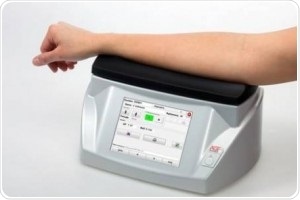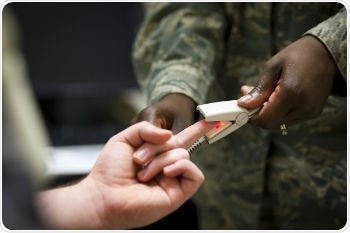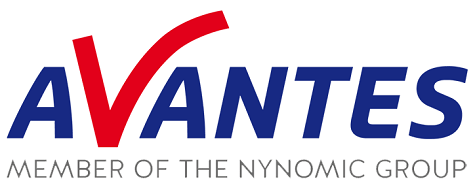Diabetes, also known as diabetes mellitus, is a chronic metabolic disorder that affects roughly 8.5% of the world’s population, i.e., over 420 million people. In the last three decades or so, rates of diabetes have almost doubled which can be attributed to adoption of western eating habits and increased urbanization in many developing countries.
Diabetes treatment involves continuous monitoring and maintenance, which places a considerable burden on the affected patients and their families and communities. In addition to this, growing rates of this disease also impose on national economies and healthcare systems.
Existing therapies and diagnostic standards for diabetes are both cumbersome and invasive, but new breakthroughs in medical sensing technology have provided medical researchers access to blood glucose monitoring and non-invasive diabetes testing. Avantes is at the forefront of new advancements that are emerging in the field of biomedical sensing.

Non-invasive testing
Current standards for the diagnosis and treatment of diabetes
Glycated hemoglobin levels or blood glucose levels should be directly measured during ongoing management and diagnosis of diabetes mellitus. Medical professionals use several methods such as fasting or random blood sugar tests and glucose tolerance tests.
These approaches are also called amperometric detection tests, when the blood sugar reacts with a reagent a small electrical charge is produced which is proportional to the sugar levels present in the sample. This is a standardized and well understood method and can be extremely accurate when carried out in a lab setting.
Although present testing methods are well-established, they continue to pose many issues to medical professionals and patients worldwide. Added to this, some cultures may have societal strictures or taboos regarding drawing of blood and as a result, securing patient compliance can be very difficult.
In addition, blood samples are not stable and hence have to be refrigerated. However, this can be a major problem in developing countries, particularly in rural regions where refrigeration and electricity may not be easily available.
Due to the chronic nature of diabetes, diabetic patients have to continuously monitor their blood glucose levels daily. This is done by collecting a small amount of blood sample, typically using a lancet prick to a finger, but then this process is very painful and can lead to further complications particularly when the patient has suppressed healing abilities and the procedure has to be frequently carried out on a day-to-day basis.
Handheld or portable blood glucose monitors are now readily available worldwide, representing about 85% of all biomedical sensors that are currently being sold for consumers. However, despite this fact, blood glucose monitoring is still a manual process and requires test strips.
Moreover, these blood testing meters, together with environmental factors such as humidity and temperature that could impact the test, may fail to provide exact measurements within all conditions.
The search for non-invasive glucose monitoring
Due to the complexities associated with blood testing across the globe as well as the repetitive and invasive nature of glucose testing, researchers are keenly looking for non-invasive options over traditional amperometric detection tests.
As such, many alternatives have been explored including carbon nanotube-based methods and electrochemical testing. Of late, the focus has moved to optical methods of detection using Raman spectroscopy and NIR absorbance.
Even scientists working with NIR spectroscopy are exploring a number of avenues. In addition, blood glucose, glycated proteins — proteins that are bonded to glucose — can be detected in fingernails and hair, in urine, and in the eye’s aqueous humors.

Two most promising methods are being studied. These include:
- using fingernails as a testing sample
- using near infrared light to determine blood glucose levels directly via the skin, with almost the same functional design as pulse oximeters
The development of standardized models for result interpretation is perhaps the biggest barrier faced by researchers when devising a novel non-invasive testing procedure for diabetes.
Measurement parameters must consider countless number of factors, including linear uptake rates and absorption patterns, which must be understood by researchers and doctors alike to create a standardized and repeatable model for understanding and predicting the spectral response.
Variations also exist across human characteristics, and it is important to neutralize these variations so that a new protocol can be standardized.
Near infrared and the diagnostic window
In biomedical applications, most of the optical sensing technology revolves around the near infrared because of a strange phenomenon, which is referred by researchers as the optical window, or the diagnostic window.
The absorption of light by human tissues is specific to certain wavelengths. The ultraviolet (UV) spectrum is absorbed by DNA and proteins; blood hemoglobin absorbs visible light; and water highly absorbs the infrared range.
However, at the extreme end of the visible spectrum, and within the near infrared (NIR) range from 650 nm to 1100 nm, there is not much absorption by either hemoglobin or water and also there is less scattering when compared to the visible and UV ranges. Interestingly, within this range, light can be used on living subjects without inducing any damage to tissues.
This can be explained as follows: in a darkened room, when a flashlight is shone through the palm of a hand, a red spot of light will be seen clearly. What is viewed is the tail end of the visible light spectrum, and the red light is between 650 and 750 nm, which falls within the 650 to 1100 nm optical diagnostic window.
This unique optical diagnostic window enables researchers and doctors to view the inside of the body. In a landmark study performed in the year 1977, Dr. Frans Jobsis from Duke University showed that both deoxygenated and oxygenated tissues exhibit discrete absorption characteristics in the NIR and since that period, NIR spectroscopy has been used for studying metabolic diseases like neurological disorders, diabetes, cardiovascular diseases, cancers, and many more diseases that afflict our societies.

Spectroscopy
New experiments were carried out in the development of optical biosensors which combined the optical window present in the NIR/Vis range with the Raman spectroscopy’s molecular fingerprinting specificity. While this technique holds immense potential, Raman analysis presents additional complication that further makes it difficult to create standardized diagnostic models.
Glycated nail protein suitability for diabetes testing
Glucose testing is very important to an increasing number of diabetic populations, and also considering the fact that the demand for glucose sensors accounts for 85% of the biosensors market, manufacturers of biomedical devices are competing to develop a breakthrough blood monitoring technology.
The assay of glycated keratin proteins is one area of analysis. Keratin is a protein that makes up our hair and fingernails and can easily bond with glucose, which is known as the glycation process. This glycation has a linear association with blood glucose levels over time.
When looking for a spectral model for diagnosing diabetes mellitus, scientists usually select fingernails because of obvious variations in the patients’ nail characteristics. Fingernails are also preferred when developing a standardized model as there is comparatively less growth rate variation than that of hair.
In this method, the use of fingernail clippings could enhance the initial diagnosis and testing of diabetes, particularly in developing countries. Fingernail clippings can be gathered painlessly and also without any need for special training.
In addition, cultural and psychological attitudes with respect to fingernail clippings are more relaxed as opposed to blood and other bodily fluids. As fingernails are stable, they can be stored without refrigeration for a number of weeks without affecting sample viability.
For testing purposes, samples of fingernail are ground and combined with a reactive agent. Fingernails are not highly permeable to such reactive agents, and therefore preparation time and possibly additional processing may be required for the samples.
While this is a minimally invasive technique, it still needs skilled sample preparation, which must be performed only in a laboratory by trained personnel and hence does not present a viable option for home glucose monitoring.
Transmittance via earlobe for home use
Researchers are developing another technique called transmittance measurement that may be used for home glucose monitoring. In fact, lobe transmittance measurements need a combination of wavelengths that are applied to the lobe of the ear at the same time.
Sensors located on both sides of the ear lobe capture the attenuated light. The reflectance of green visible light is first utilized to establish skin parameters, for example the thickness of tissue. The transmittance and absorption of red light is then used to establish the volume of blood, and the NIR wavelength is finally utilized to establish glucose concentrations.
This technique shows immense potential because it uses a simple design in which the ear lobe clip is coupled to a spectrometer using fiber cables. This makes it easy and simple for even novice users and does not require any special training. Further, the easy design and lack of sample preparation means that this method eliminates laboratory oversight and can be carried out by individuals.
Overcoming barriers to optical glucose monitoring
In many diagnostic techniques that are being studied today, one major obstacle to complete testing validation is the ability of researchers to resolve separate variation to develop a standardized model for the interpretation of results. The efforts of these experts and researchers bring us closer to the possibility of accurate, non-invasive, and inexpensive blood glucose monitoring options.
Although it is not possible to predict when exactly a novel technology or method will win the approval of medical certifying bodies, including Federal Drug Administration (FDA), the possibility is turning out to be more realistic.
In the coming days, patients suffering from diabetes will no longer have to go through painful blood testing protocols, all due to the efforts of dedicated doctors, researchers, and scientists working on novel optical testing procedures.
Avantes on the forefront of medical research
Avantes is at the forefront of this study. The company’s equipment has been installed in laboratories across the globe, supporting researchers and doctors working on diabetes studies.
Dr. Angelika M. Domschke, who was earlier working at the University of Hamburg, is using the Avantes AvaSpec-ULS2048 to study ophthalmic glucose monitoring. The aim of this study is to test and track the development of a contact lens that is applied to the eye and offers nonstop monitoring.
With the AvaSpec-ULS2048, Dr. Domschke and her team were able to obtain a signal to noise ratio of 200:1 and an excellent response speed. This demonstrates the consistent function of the Avantes StarLine spectrometers.

At Groningen University in the Netherlands, scientists are investigating skin fluorescence to track vascular damage. Diabetics are susceptible to poor circulation, vascular damage, and gradual healing in their extremities.
The aim of this research is to simplify the treatment of diabetic foot complications. While the researchers used an older Avantes model for their study, the AvaSpec-HS1024x58/122TEC continues to provide the highest sensitivity, thanks to the thermo-electrically cooled, back-thinned detector and 0.22 numerical aperture of the optical bench. The system is suitable to meet the demands of high sensitivity NIR measurements.
In his doctoral thesis at MIT Department of Mechanical Engineering, Dr. Ishan Barman explored the difficulty of creating accurate diagnostic models using NIR Raman spectroscopy.
In his analysis titled, “Unraveling the puzzles of spectroscopy-based non-invasive blood glucose detection,” Barman’s advice for a spectrometer elucidates a system that matches the exact specifications of the AvaSpec-HS1024x58TEC (AvaSpec-HERO) instrument.
This is one instrument that provides optimal sensitivity with a 0.22 numerical aperture; this aperture gathers the entire light carried by a fiber optic. The AvaSpec-HERO also provides the optimal balance between high resolution and high sensitivity, along with a TE Cooled back-thinned detector. It can even facilitate extended integration times in low light applications and hence it is the preferred instrument in Raman systems.
Researchers worldwide use Avantes instruments for their biomedical studies. The Avantes SensLine of spectrometers includes a number of models that are customized for low light level applications with thermoelectrically or standard cooled options.
The Avantes CompactLine of miniature spectrometers provides another interesting solution. These instruments are compact yet powerful. Measuring about the size of a deck of cards, the instrument performs on par with many of the company’s larger form factor counterparts.
Customers can contact Avantes Sales Engineers to find out the right Avantes system for their biomedical research application.
Resources
About Avantes BV
 Avantes is a leading innovator in the development and application of miniatures spectrometers. Avantes continues to develop and introduce new instruments for fiber optic spectroscopy to meet our customer’s application needs.
Avantes is a leading innovator in the development and application of miniatures spectrometers. Avantes continues to develop and introduce new instruments for fiber optic spectroscopy to meet our customer’s application needs.
Avantes instruments and accessories are also deployed into a variety of OEM applications in a variety of industries in markets throughout the world.
With more than 18 years of experience in fiber optic spectroscopy and thousands of instruments in the field, Avantes is eager to help our customers find their Solutions in Spectroscopy®.
Techniques Supported
- UV-VIS/NIR spectroscopy
- Process control
- Absorbance/transmittance/reflectance
- Laser-induced breakdown spectroscopy
- CIE color spectroscopy
- Portable spectrometers
- Fluorescence spectroscopy
- Custom applications
- lrradiance
- Raman spectroscopy
- OEM application development
Major Products/Services
Low-cost. high-resolution, miniature fiber optic spectrometers: System solutions and OEM instruments for applications from 185 nm to 2500 nm. Detector choices: PDA, CMOS, CCD, back-thinned CCD, and lnGaAs.
Optical benches with focal lengths of 45, SO or 75 mm; revolutionary new ultra-low straylight
optimized optical bench (ULS) and a new high sensitivity optical bench.
Other Features
- 14 and 16 bit AID converters
- TE cooling
- multi-channel instrument configurations enabling simultaneous signal acquisition
- USB2 communication
- support for multiple instruments from a single computer
- 14 programmable digital I/O ports
Standard Application Solutions
- lrradiance and LED measurements
- gemology
- hemometric analysis
- thin-film measurement
- color
- fluorescence
- laser-induced breakdown spectroscopy (LIBS)
- Raman spectroscopy
- process control
Light Sources
- Tungsten-halogen
- Deuterium
- LED
- Xenon calibration sources for wavelength and irradiance
Sponsored Content Policy: News-Medical.net publishes articles and related content that may be derived from sources where we have existing commercial relationships, provided such content adds value to the core editorial ethos of News-Medical.Net which is to educate and inform site visitors interested in medical research, science, medical devices and treatments.